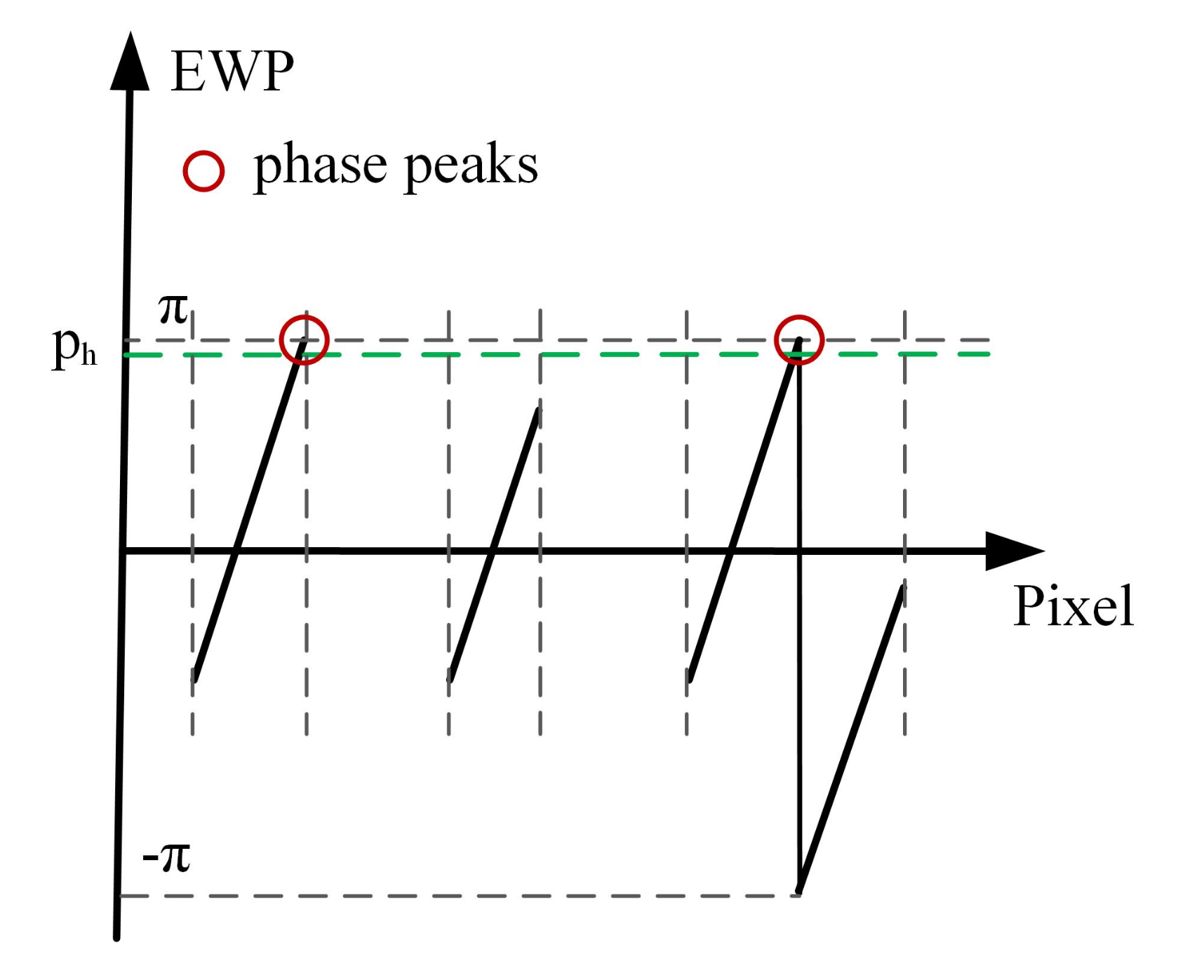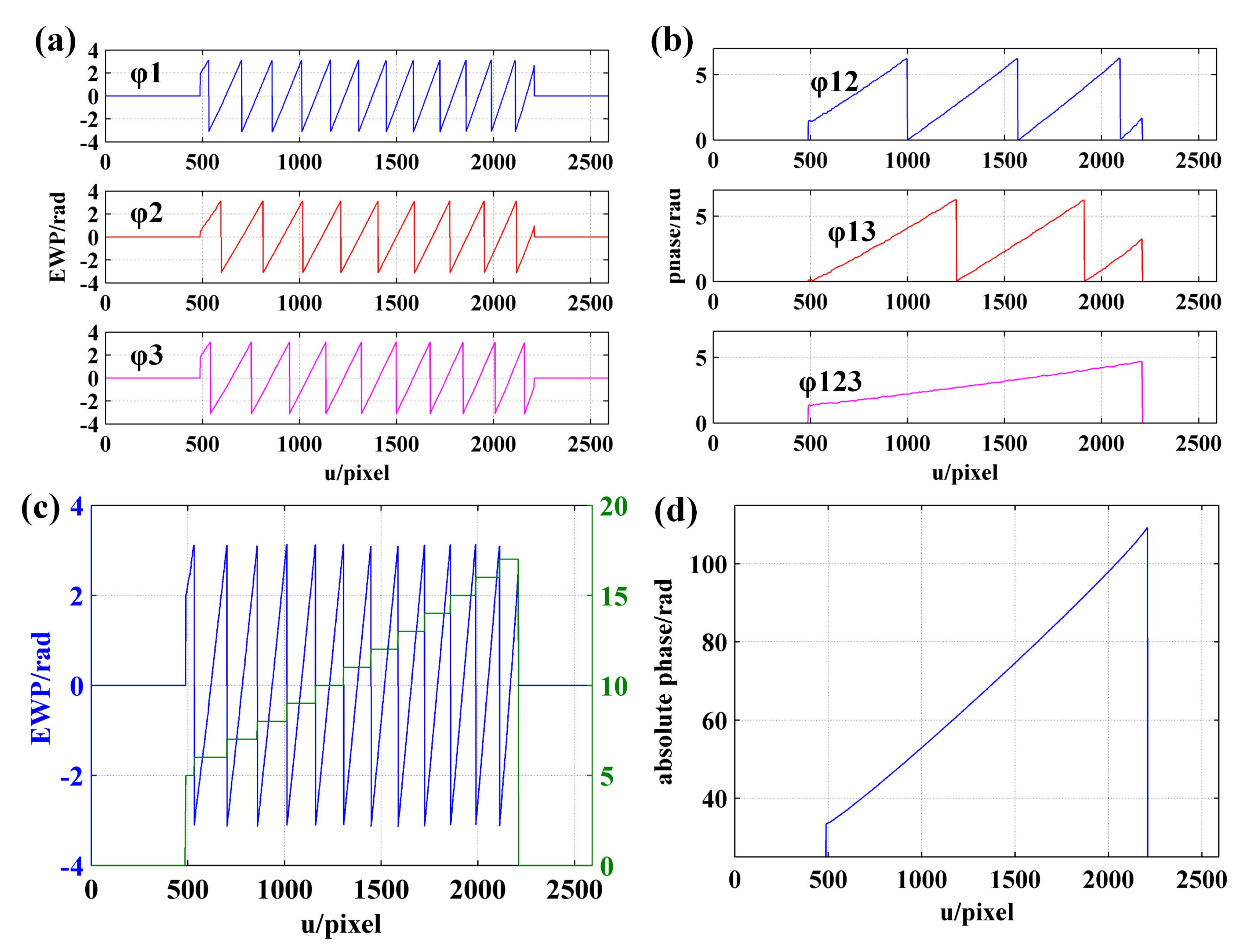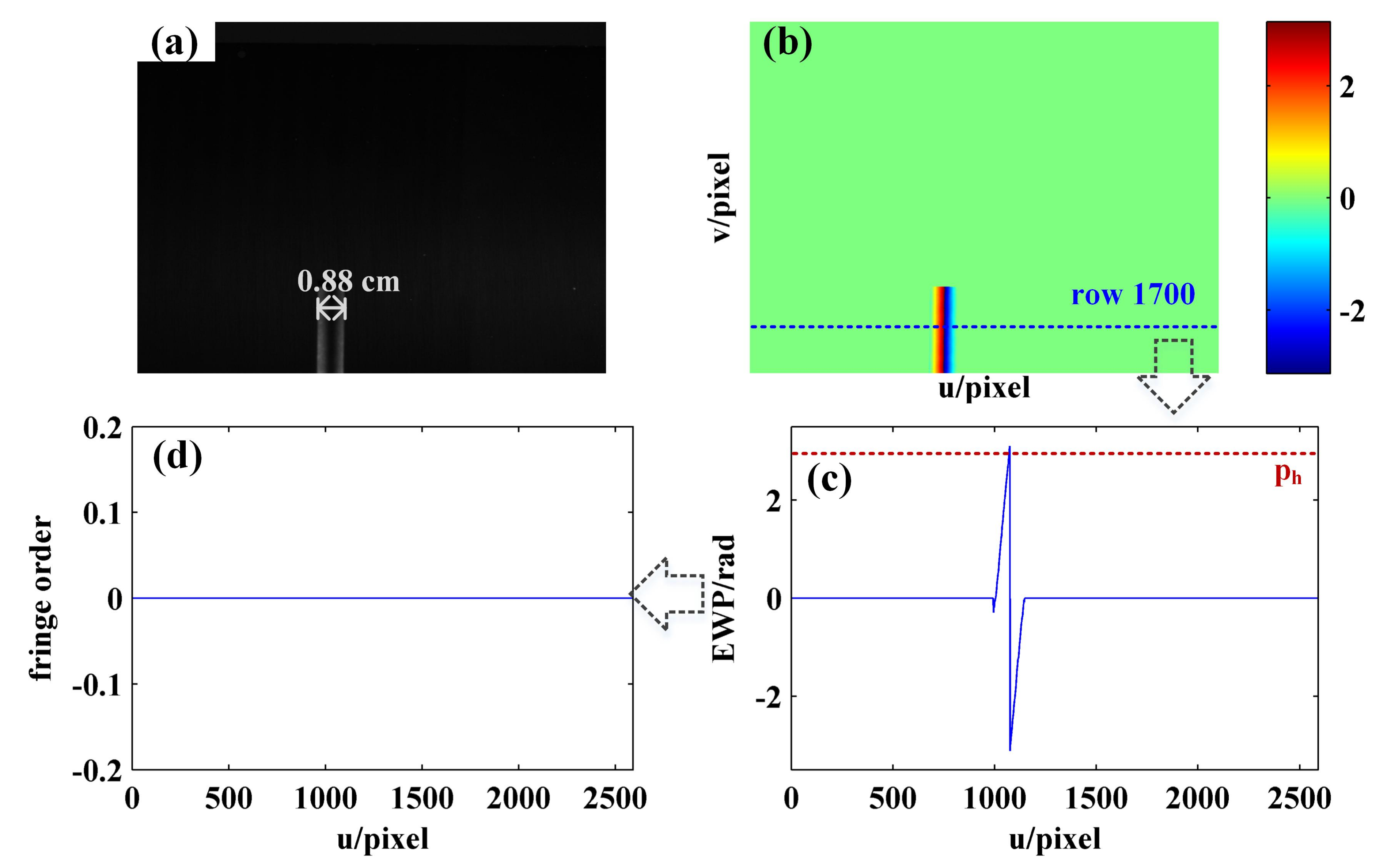Phase Demodulation Method for Fringe Projection Measurement Based on Improved Variable-Frequency Coded Patterns
Abstract
:1. Introduction
2. Encoding and Decoding Principle of the Dual VF Coded Patterns
2.1. Encoding Principle
2.2. Decoding Principle
3. Application of Dual VF Coded Patterns in Phase Demodulation
3.1. EWP Calculation
3.2. Orders Decoding with Dual VF Coded Patterns
- Step 1.
- Initialization is carried out. The fringe order set is initialized to .
- Step 2.
- EWP classification is performed. On the whole, the period of the sinusoidal fringes projected on the object is not necessarily complete. Accordingly, by setting a phase threshold to be slightly less than , all phase peaks with phase greater than are recorded. The region containing at least two phase peaks is defined as the wrapped phase region with complete period (Figure 4). Otherwise, it is the wrapped phase region without complete period (Figure 5).
- Step 3.
- The wrapped phase region with complete period is further divided into complete-period phase region and boundary phase region (left boundary and right boundary). As shown in Figure 4, the phase peak index set is , of which the wrapped phase value is higher than . It is defined that the phase located in pixel interval is the complete-period phase, and the pixel interval is the complete-period phase region. The pixel interval is taken as the left boundary phase region, the pixel interval is treated as the right boundary phase region, and the wrapped phase located at the boundary phase region is classed as the boundary phase.
- Step 4.
- The orders decoding of the fringes corresponding to the complete-period phase is performed. According to the description made in Section 2.2, the frequency ( and ) of the two VF fringes (VF1 and VF2) in each pixel interval can be calculated. Then, the orders of the fringes corresponding to complete-period phase are obtained using the formula .
- Step 5.
- The orders decoding of the fringes corresponding to boundary phase is performed. According to the continuity of the fringe orders in the direction of fringe projection, the order of the fringe corresponding to left boundary phase is , and the order of the fringe corresponding to right boundary is . Given the whole wrapped phase region with complete period, the corresponding fringe orders can be expressed as .
- Step 6.
- The orders decoding of the fringes corresponding to the wrapped phase without complete period is performed. When the number of phase peaks above the phase threshold is less than 2, it is considered that there is no sinusoidal fringe with complete period in the current decoding period, as shown in Figure 5. To determine the fringe orders corresponding to the incomplete-period wrapped phase, all connected regions with phase greater than 0 and less than or equal to 0 are identified to identify the semiperiodic connected regions of wrapped phase (Figure 6). Since the sinusoidal fringes in the same connected region fall within the same period, the fringe orders located in the same phase connected region are equal. As shown in Figure 6, the fringe orders of region 1 are equal to that of region 3, while the fringe orders of region 2 are equal to that of region 4. Therefore, the fringe orders corresponding to the wrapped phase region without complete period can be determined according to that of complete period.
3.3. Unwrapped Phase Demodulation
4. Experiment and Analysis
4.1. Experimental System Construction
4.2. Phase Unwrapping of Surface Continuous Object
4.3. Phase Unwrapping of Surface Discontinuous Object
4.4. Phase Demodulation of the Object with Height Abrupt Change
5. Conclusions
- 1.
- Throughout the phase demodulation process, there are as few as two additional VF coded patterns required except for the sinusoidal patterns used to determine the wrapped phase, which is conducive to reducing the number of projected patterns and making the measurement process easier to carry out.
- 2.
- Since the two coded fringes are decoded in the same interval as the wrapped phase, the phase jump error of 2 is eliminated from the absolute phase demodulated using the proposed method. Thus, it is needless to perform the subsequent phase filtering or fringe orders correction operation.
- 3.
- In respect of orders decoding, the sampling frequency of FFT algorithm is equal to the length of the current decoding interval, which can be adjusted automatically depending on the surface variation of the object. Thus, this method can be applied to achieve phase demodulation for both smooth surface objects and the objects with abrupt height change.
6. Discussion
Author Contributions
Funding
Data Availability Statement
Conflicts of Interest
References
- Marrugo, A.; Gao, F.; Zhang, S. State-of-the-art active optical techniques for three- dimensional surface metrology: A review. J. Opt. Soc. Am. A Opt. Image Sci. Vis. 2020, 37, B60–B77. [Google Scholar] [CrossRef] [PubMed]
- Zuo, C.; Huang, L.; Zhang, M.; Chen, Q.; Asundi, A. Temporal phase unwrapping algorithms for fringe projection profilometry: A comparative review. Opt. Lasers Eng. 2016, 85, 84–103. [Google Scholar] [CrossRef]
- Zhang, S. Absolute phase retrieval methods for digital fringe projection profilometry: A review. Opt. Lasers Eng. 2018, 107, 28–37. [Google Scholar] [CrossRef]
- Gorthi, S.; Rastogi, P. Fringe projection techniques: Whither we are? Opt. Lasers Eng. 2010, 48, 133–140. [Google Scholar] [CrossRef] [Green Version]
- Wang, J.; Yang, Y. Double N-step phase-shifting profilometry using color-encoded grating projection. Chin. Opt. 2019, 12, 616–627. [Google Scholar] [CrossRef]
- Sansoni, G.; Carocci, M.; Rodella, R. Three-Dimensional Vision Based on a Combination of Gray-Code and Phase-Shift Light Projection: Analysis and Compensation of the Systematic Errors. Appl. Opt. 1999, 38, 6565–6573. [Google Scholar] [CrossRef] [Green Version]
- Saldner, H.; Huntley, J. Temporal phase unwrapping: Application to surface profiling of discontinuous objects. Appl. Opt. 1997, 36, 2770–2775. [Google Scholar] [CrossRef] [PubMed]
- Porras-Aguilar, R.; Falaggis, K. Absolute phase recovery in structured light illumination systems: Sinusoidal vs. intensity discrete patternsn. Opt. Lasers Eng. 2016, 84, 111–119. [Google Scholar] [CrossRef]
- Zhang, H.; Zhao, H.; Zhao, Z.; Zhuang, Y.; Fan, C. Two-frame fringe pattern phase demodulation using Gram-Schmidt orthonormalization with least squares method. Opt. Express 2019, 27, 10495–10508. [Google Scholar] [CrossRef]
- Kulkarni, R.; Rastogi, P. Phase unwrapping algorithm using polynomial phase approximation and linear Kalman filter. Appl. Opt. 2018, 57, 702–708. [Google Scholar] [CrossRef] [PubMed]
- Bone, D. Fourier fringe analysis: The two-dimensional phase unwrapping problem. Appl. Opt. 1991, 30, 3627–3632. [Google Scholar] [CrossRef] [PubMed]
- Su, X.; Chen, W. Reliability-guided phase unwrapping algorithm: A review. Opt. Lasers Eng. 2004, 42, 245–261. [Google Scholar] [CrossRef]
- Ghiglia, D.; Pritt, M. Two-Dimensional Phase Unwrapping: Theory, Algorithms, and Software; Wiley: Hoboken, NJ, USA, 1998. [Google Scholar]
- Xing, Y.; Quan, C.; Tay, C. A modified phase-coding method for absolute phase retrieval. Opt. Lasers Eng. 2016, 87, 97–102. [Google Scholar] [CrossRef]
- Porrasaguilar, R.; Falaggis, K.; Ramosgarcia, R. Error correcting coding-theory for structured light illumination systems. Opt. Lasers Eng. 2017, 93, 146–155. [Google Scholar] [CrossRef]
- Wang, Y.; Chen, X.; Huang, L.; Li, Q.; Huang, W. Improved phase-coding methods with fewer patterns for 3D shape measurement. Opt. Commun. 2017, 401, 6–10. [Google Scholar] [CrossRef]
- Posdamer, J.; Altschuler, M. Surface measurement by space-encoded projected beam systems. Comput. Graph. Image Process. 1982, 18, 1–17. [Google Scholar] [CrossRef]
- Jiang, L. Digital Logic Circuits and System Design; Electronic Industry Press: Beijing, China, 2008. [Google Scholar]
- Bui, L.; Lee, S. Boundary Inheritance Codec for high-accuracy structured light three-dimensional reconstruction with comparative performance evaluation. Appl. Opt. 2013, 52, 5355–5370. [Google Scholar] [CrossRef]
- Zhang, Q.; Su, X.; Xiang, L.; Sun, X. 3-D shape measurement based on complementary Gray-code light. Opt. Lasers Eng. 2012, 50, 574–579. [Google Scholar] [CrossRef]
- Zheng, D.; Da, F.; Kemao, Q.; Seah, H. Phase-shifting profilometry combined with Gray-code patterns projection: Unwrapping error removal by an adaptive median filter. Opt. Express 2017, 25, 4700–4713. [Google Scholar] [CrossRef]
- Song, L.; Chang, Y.; Li, Z.; Wang, P.; Xing, G.; Xi, J. Application of global phase filtering method in multi frequency measurement. Opt. Express 2014, 22, 13641–13647. [Google Scholar] [CrossRef]
- Xiao, S.; Tao, W.; Zhao, H. Absolute Phase Acquisition Method for Spatial Discontinuous Three-Dimensional Object Surface Based on Encoding Grating. Acta Opt. Sin. 2016, 36, 1212004-1–1212004-8. [Google Scholar] [CrossRef]
- Xiao, S.; Tao, W.; Zhao, H. A Flexible Fringe Projection Vision System with Extended Mathematical Model for Accurate Three-Dimensional Measurement. Sensors 2016, 16, 612. [Google Scholar] [CrossRef] [Green Version]
- Spagnolo, G.; Guattari, G.; Sapia, C.; Ambrosini, D.; Paoletti, D.; Accoardo, G. Contouring of artwork surface by fringe projection and FFT analysis. Opt. Lasers Eng. 2000, 33, 141–156. [Google Scholar] [CrossRef]
- Wang, Y.; Zhang, S. Novel phase-coding method for absolute phase retrieval. Opt. Lett. 2012, 37, 2067–2069. [Google Scholar] [CrossRef]
- Zheng, D.; Da, F. Phase coding method for absolute phase retrieval with a large number of codewords. Opt. Express 2012, 20, 24139–24150. [Google Scholar] [CrossRef]
- Chen, X.; Wang, Y.; Wang, Y.; Ma, M.; Zeng, C. Quantized phase coding and connected region labeling for absolute phase retrieval. Opt. Express 2016, 24, 28613–28624. [Google Scholar] [CrossRef]
- Liu, K.; Wang, Y.; Lau, D.; Hao, Q.; Hassebrook, L. Dual-frequency pattern scheme for high-speed 3-D shape measurement. Opt. Express 2010, 18, 5229–5244. [Google Scholar] [CrossRef] [PubMed] [Green Version]
- Wang, Y.; Laughner, J.; Efimov, I.; Zhang, S. 3D absolute shape measurement of live rabbit hearts with a superfast two-frequency phase-shifting technique. Opt. Express 2013, 21, 5822–5832. [Google Scholar] [CrossRef] [PubMed] [Green Version]
- Karpinsky, N.; Hoke, M.; Chen, V.; Zhang, S. High-resolution, real-time three-dimensional shape measurement on graphics processing unit. Opt. Eng. 2014, 53, 024105. [Google Scholar] [CrossRef]
- Li, Z.; Zhong, K.; Li, Y.; Zhou, X.; Shi, Y. Multiview phase shifting: A full-resolution and high-speed 3D measurement framework for arbitrary shape dynamic objects. Opt. Lett. 2013, 38, 1389–1391. [Google Scholar] [CrossRef] [PubMed]
- Zhong, K.; Li, Z.; Shi, Y.; Wang, C.; Lei, Y. Fast phase measurement profilometry for arbitrary shape objects without phase unwrapping. Opt. Lasers Eng. 2013, 51, 213–222. [Google Scholar] [CrossRef]
- Huddart, Y.; Valera, J.; Weston, N.; Moore, A. Absolute phase measurement in fringe projection using multiple perspectives. Opt. Express 2013, 21, 21119–21130. [Google Scholar] [CrossRef]
- An, Y.; Hyun, J.; Zhang, S. Pixel-wise absolute phase unwrapping using geometric constraints of structured light system. Opt. Express 2016, 24, 18445–18459. [Google Scholar] [CrossRef] [PubMed]
- Jiang, C.; Li, B.; Zhang, S. Pixel-by-pixel absolute phase retrieval using three phase-shifted fringe patterns without markers. Opt. Lasers Eng. 2017, 91, 232–241. [Google Scholar] [CrossRef]
- Xie, G.; Cao, Q.X.; Xia, N. Picking up the powdering region of galvanized steel sheets based on machine vision. J. Huazhong Univ. Sci. Technol. 2016, 34, 35–38. [Google Scholar]
- Fischer, M.; Petz, M.; Tutsch, R. Vorhersage des Phasenrauschens in optischen Messsystemen mit strukturierter Beleuchtung. Plattf. Methoden Systeme Anwendungen Messtechnik 2012, 79, 451–458. [Google Scholar] [CrossRef]
- Yu, S.; Zhang, J.; Yu, X.; Sun, X.; Wu, H. Unequal-period combination approach of gray code and phase-shifting for 3-D visual measurement. Opt. Commun. 2016, 374, 97–106. [Google Scholar] [CrossRef]
- Li, J.; Guan, J.; Du, H.; Xi, J. Error self-correction method for phase jump in multifrequency phase-shifting structured light. Appl. Opt. 2021, 60, 949–958. [Google Scholar] [CrossRef]






















| Methods | Sphere | Three-Blade Fan | Step Workpiece |
|---|---|---|---|
| three-frequency phase-shift method | 13.533 s | 15.118 s | 13.418 s |
| proposed method | 22.0626 s | 25.216 s | 20.594 s |
| Methods | Minimum Number | To Decode 10 Fringe Orders | To Decode 100 Fringe Orders | To Decode 1000 Fringe Orders |
|---|---|---|---|---|
| multi-frequency phase-shift method | 3 | 3,6,9, … | 3,6,9, … | 6,9,12, … |
| Gray coded method | 1 | 4 | 7 | 10 |
| proposed method | 1 | 2 | 3 | 4 |
Publisher’s Note: MDPI stays neutral with regard to jurisdictional claims in published maps and institutional affiliations. |
© 2021 by the authors. Licensee MDPI, Basel, Switzerland. This article is an open access article distributed under the terms and conditions of the Creative Commons Attribution (CC BY) license (https://creativecommons.org/licenses/by/4.0/).
Share and Cite
Lv, S.; Jiang, M.; Su, C.; Zhang, L.; Zhang, F.; Sui, Q.; Jia, L. Phase Demodulation Method for Fringe Projection Measurement Based on Improved Variable-Frequency Coded Patterns. Sensors 2021, 21, 4463. https://doi.org/10.3390/s21134463
Lv S, Jiang M, Su C, Zhang L, Zhang F, Sui Q, Jia L. Phase Demodulation Method for Fringe Projection Measurement Based on Improved Variable-Frequency Coded Patterns. Sensors. 2021; 21(13):4463. https://doi.org/10.3390/s21134463
Chicago/Turabian StyleLv, Shanshan, Mingshun Jiang, Chenhui Su, Lei Zhang, Faye Zhang, Qingmei Sui, and Lei Jia. 2021. "Phase Demodulation Method for Fringe Projection Measurement Based on Improved Variable-Frequency Coded Patterns" Sensors 21, no. 13: 4463. https://doi.org/10.3390/s21134463
APA StyleLv, S., Jiang, M., Su, C., Zhang, L., Zhang, F., Sui, Q., & Jia, L. (2021). Phase Demodulation Method for Fringe Projection Measurement Based on Improved Variable-Frequency Coded Patterns. Sensors, 21(13), 4463. https://doi.org/10.3390/s21134463







